Siberian Huskies are stunning dogs, but their shedding can be a challenge, especially in the UK's warmer climate. Managing their abundant fur requires specific strategies tailored to the heat. Discover essential tips and tricks that can help you maintain a comfortable environment for your pup while keeping your home fur-free. From grooming techniques to dietary adjustments, learn how to master shedding solutions that work best for your Siberian Husky in a warm climate.
Understanding Shedding in Siberian Huskies
Siberian Huskies are known for their distinctive double coat, which plays a crucial role in their shedding patterns. This breed's coat consists of a dense undercoat and a longer, protective outer layer. The undercoat is responsible for insulating the dog in cold climates, while the outer coat repels moisture and dirt.
A lire en complément : Building a Secure Outdoor Habitat for Pygmy Goats: A Guide for Welsh Countryside Enthusiasts
Siberian Husky shedding is significantly influenced by seasonal changes, particularly during the transition from winter to spring and summer to autumn. During these periods, known as "blowing the coat," Huskies shed their undercoat to adapt to the changing temperatures. This process can be quite dramatic, with large amounts of fur being released over a short period.
In warmer climates, Siberian Husky shedding can be more continuous and less predictable. The dog's coat may not develop as thickly, leading to a more frequent shedding cycle throughout the year. This adaptation helps Huskies regulate their body temperature in environments they are not naturally accustomed to.
Sujet a lire : Building a Secure Outdoor Habitat for Pygmy Goats: A Guide for Welsh Countryside Enthusiasts
Understanding the seasonal shedding patterns and the factors that influence them can help owners manage their pet's coat more effectively. Regular grooming and maintaining a clean living environment are essential to minimizing the impact of shedding on both the dog and the household.
Grooming Techniques for Effective Shedding Management
Managing Siberian Husky shedding requires understanding the best grooming tips and brushing techniques. Regular brushing is essential to keep shedding under control. A slicker brush is highly recommended for daily use, as it effectively removes loose fur from the undercoat. For deeper grooming, a rake brush can be used weekly to reach the thicker undercoat layers.
In warmer climates, grooming frequency should increase. Daily brushing helps prevent matting and reduces the amount of fur shed around the home. This practice not only keeps the coat healthy but also allows the skin to breathe, promoting better overall health.
When brushing, it's crucial to be gentle yet thorough. Start from the head and work your way down to the tail, ensuring all areas are covered. Pay special attention to the undercoat, as this is where most shedding originates.
To minimize shedding during grooming, consider using a deshedding tool. These tools are designed to remove loose fur efficiently without damaging the topcoat. Additionally, regular baths with a mild dog shampoo can help loosen dead fur, making it easier to brush out. This combination of techniques ensures a cleaner home and a happier, healthier Husky.
Essential Tools for Managing Shedding
Understanding the right grooming tools is crucial for managing Siberian Husky shedding. A variety of tools are available, each designed to tackle different aspects of a Husky's double coat.
Shedding Brushes and Combs
Shedding brushes are indispensable for removing loose fur from the undercoat. A slicker brush is ideal for daily use, effectively capturing stray hairs and preventing matting. For a more thorough grooming session, a rake brush can reach deeper layers of the undercoat. These brushes are specifically designed to handle the dense fur of Huskies, making them a must-have in your grooming arsenal.
Combs, on the other hand, are excellent for finishing touches. They help detangle any remaining knots and smooth out the fur after brushing. A wide-toothed comb works best for Huskies, as it glides through the coat without causing discomfort.
Tool Maintenance
Regular maintenance of your grooming tools is essential for optimal performance. Clean brushes and combs after each use to remove accumulated fur and debris. This not only extends the lifespan of the tools but also ensures your Husky's coat remains healthy and well-groomed. Properly maintained tools lead to more effective grooming sessions, reducing shedding and promoting a cleaner living environment.
Dietary Considerations for Healthy Coats
A Siberian Husky's coat health is significantly influenced by its diet. Proper dog nutrition can help manage shedding and improve overall coat quality. A balanced diet rich in essential nutrients promotes a shiny, healthy coat and reduces excessive shedding.
Impact of Diet on Shedding
The right diet can make a noticeable difference in a Husky's shedding patterns. Foods rich in omega-3 and omega-6 fatty acids are particularly beneficial, as they help maintain skin moisture and reduce inflammation. These nutrients are often found in fish oils and flaxseeds, making them excellent additions to your dog's diet.
Nutritional Supplements
Dietary supplements can also play a crucial role in enhancing coat health. Supplements containing biotin, zinc, and vitamins A and E are recommended for Huskies. These nutrients support skin health and promote a robust, lustrous coat. It's essential to consult with a veterinarian before introducing any new supplements to ensure they meet your dog's specific needs.
Foods for Optimal Coat Health
Incorporate foods like salmon, sweet potatoes, and pumpkin into your Husky's diet. These ingredients are not only nutritious but also support coat health. Maintaining a balanced diet with these elements can significantly impact the quality of your Husky's coat.
Managing Temperature and Comfort
Ensuring dog comfort in warm climates is crucial for Siberian Huskies, given their thick double coats. Effective temperature control strategies can help prevent overheating and maintain a comfortable environment for your pet.
Cooling strategies are essential during hot weather. Providing ample shade in outdoor areas is a simple yet effective way to keep your Husky cool. Ensure they have access to shaded spots in the garden or patio, especially during peak sunlight hours. Additionally, hydration is vital. Always have fresh, cool water available, and consider using a pet water fountain to encourage frequent drinking.
Indoor temperature control is equally important. Air conditioning can be beneficial in maintaining a cool environment, but if it's unavailable, fans and open windows can help circulate air. Consider placing cooling mats in your Husky's favourite resting spots to provide additional relief from the heat.
It's also important to adjust your Husky's routine during warmer months. Plan walks and outdoor activities during cooler parts of the day, such as early morning or late evening, to minimise exposure to high temperatures. These measures ensure your Husky remains comfortable and healthy even in challenging climates.
Health Implications of Excessive Shedding
Excessive shedding health issues in Siberian Huskies can sometimes indicate underlying skin conditions. While shedding is normal, unusual patterns or amounts of fur loss may signal health concerns. Common issues include allergies, infections, or parasites, which can lead to irritated skin and increased shedding.
Recognising Signs of Health Problems
Be vigilant for symptoms such as bald spots, redness, or persistent itching, as these may suggest skin conditions. Changes in shedding patterns, like sudden increases or uneven hair loss, can also be warning signs of health issues. Observing these indicators early can prevent more severe problems.
When to Seek Vet Advice
Consult a veterinarian if you notice any of the aforementioned symptoms. Professional vet advice is crucial to diagnose and treat any underlying health issues effectively. Vets can perform tests to identify specific causes, such as allergies or infections, and recommend appropriate treatments.
Understanding the connection between shedding and health can help ensure your Husky remains in optimal condition. Regular check-ups and prompt attention to any unusual shedding patterns are essential for maintaining your dog's well-being.
Maintaining a Clean Home Amidst Shedding
Keeping a home tidy with a shedding Siberian Husky can be challenging, but with the right home cleaning tips, it becomes manageable. Regular vacuuming is essential for effective pet hair removal. Opt for a vacuum cleaner with a HEPA filter, designed to trap fine particles and reduce allergens. For hard floors, a microfiber mop is excellent for capturing loose fur.
Incorporate household management strategies by designating specific areas for your Husky to lounge, minimising fur spread. Cover furniture with washable throws to protect them from hair accumulation. Regularly washing these covers helps maintain a clean environment.
Recommended Products for Dog Hair Management
- Lint rollers: Handy for quick clean-ups on clothing and upholstery.
- Pet hair remover gloves: Useful for removing hair from furniture and fabrics.
- Air purifiers: Help reduce airborne pet hair and allergens, improving indoor air quality.
Develop a shedding management routine by establishing a consistent cleaning schedule. Regularly clean pet bedding and toys to prevent fur build-up. By integrating these strategies, you can effectively manage pet hair, ensuring a cleaner, more comfortable home environment.
User Experiences and Expert Insights
Understanding shedding management for Siberian Huskies can be enriched by exploring both user stories and expert advice. Owners often share valuable experiences, highlighting the effectiveness of various community tips. For instance, many have found success in using regular grooming routines to manage shedding, especially in warm climates. These user stories emphasize the importance of consistency and patience.
Professional groomers and veterinarians provide essential insights into maintaining a healthy coat. Experts recommend using specific tools and techniques tailored to Huskies' unique double coat. Groomers often advise owners to adjust grooming frequency based on climate, ensuring that the dog's skin remains healthy and free from irritation.
In addition to professional guidance, community-driven tips can offer practical solutions. Owners frequently suggest creating a supportive environment by utilizing cooling mats and ensuring ample hydration. These strategies not only help in managing shedding but also enhance the overall comfort of the Husky.
By combining expert advice with community tips, owners can develop a comprehensive approach to managing their Husky's shedding. This blend of insights ensures a well-rounded understanding, fostering a harmonious relationship between pet and owner.










